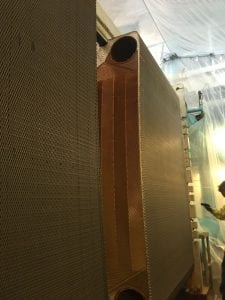Since the early 1900s, Cornell has distributed steam using buried pipes in a district energy system to heat its buildings. For many years, heat was transferred from steam to hot water within each building using a heat exchanger with heated water circulated throughout the building. Today, an expanding portion of campus is served by lower-temperature water that is heated at a more central location by steam converters. Future buildings (effective 2018) will also be designed to use hot water for heat, but at lower service and return temperatures than in the past. The ESH project system design is based on serving this current and future delivery system.
With support from the Department of Energy’s program “Deep Direct Use Geothermal”, we evaluated the feasibility of meeting the building heat demands using a pair of geothermal wells. The results, available in the final report, are very encouraging — with innovative engineering design of the surface energy use system, real benefit can be extracted from geothermal hot water sourced from a wide range of geological reservoirs located below Cornell.

In order to accurately determine temperature needs and consider candidates for “cascading energy use”, the Cornell Study team segregated all building types into three categories. Modelling programs are being used to determine “required temperatures”.
1) “High Temperature Facilities” such as research and teaching labs that require large make-up air flows. The minimum supply temperature is 82°C (180°F).
2) “Standard Temperature Facilities” such as typical teaching spaces, offices and dormitories, at a minimum supply temperature of 70°C (158°F).
3) “Low Temperature Facilities” that may be able to utilize “return” water from other building systems, at minimum supply temperatures of 60°C (140°F). This will include most future building stock, since Cornell has recently amended their campus standard for all buildings to reflect this lower temperature.

The project proposes to use specialty-use heat pumps to improve ground fluid heat extraction and to provide targeted temperature “boosting” at buildings that have not yet been upgraded to accept lower temperature heating fluids. Hot water storage will be used to reduce infrequent demand peaks. Plate-and-Frame heat exchangers designed for close approach temperatures, similar to those used elsewhere on campus, will be used to exchange heat between the primary geothermal pumping system and the Distribution System.
Evaluation of costs and benefits of various modes of heat pump operations will also be compared with designs that don’t use these supplemental specialty-use heat pump systems.
